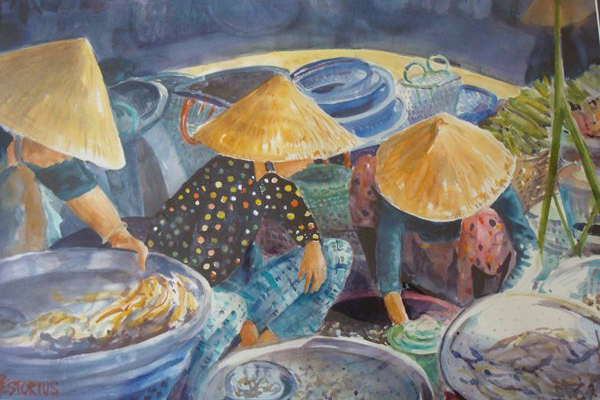Painter Luong Xuan Doan said, “The crisis comes from the artists’ unsound soul and ideas in the context of the national economic boom.”
It’s no joke, in a typical month a local artist can create up to 40 paintings.
Some artists, who have earned a good reputation, hire fine arts students or little known painters to paint from photographs of their previous works, which they sign and sell.
Today an artists’ income can be a hundred times more than in the 1990s.
But it was from 1990-1996 that Vietnamese paintings were most sought after in foreign markets, when thousands of paintings were being sold in Europe and Japan.
Some sold at US$20,000, while a copy of a famous painting today sells for a maximum of $300.
Western clients have less interest in Vietnamese paintings because of the fakes and the “half Asian half Western style”, experts say.
Shoddy art and imitations have downgraded the value of work by Vietnam’s best artists.
In 1998-2000, Vietnamese paintings accounted for 70 percent of the sales at the well known and respected Thavibu Gallery in Bangkok, which specializes in Thai, Vietnamese and Burmese art works.
Last year Vietnamese art only accounted for 29 percent.
Russian art expert and owner of Natasha Gallery in Hanoi, Dr. Natalia Kraevskaia, said due to the state’s open policy, several artists either recreated their products excessively or absorbed too many foreign values, which led to the loss of their Vietnamese style and uniqueness.
In August, in a shocking indictment on Vietnamese fine art, judges in the HCMC Fine Arts Creation Campus failed to award a first prize, though 160 paintings entered.
Deputy Chairman of the HCMC Fine Arts Association Huynh Van Muoi said,
“The painters have captured beautiful rural lives in diversified themes about nature and human beings. Nevertheless, no piece is actually prominent.”
Foreigners’ fresh perspective
Since Vietnamese art flourished in 1990, many visiting foreign artists inspired by what they have found here, settled in the country to paint or draw.
Somboon Phoungdorkmai, a painter from Thailand, paints in water colors about life in Hanoi.
She captures the stillness and truth of tranquil moments in Hanoi with her brush.
In the last two years, Somboon traveled to the Vietnamese capital five times, producing 20 paintings and several sketches.
Somboom said she arranged her work in Hanoi to experience the four seasons of the city, capturing the coldness of Hanoi’s winter and the splashes of sunlight on the old French style walls.
Two weeks ago, she was part of a group exhibition at the Hanoi Viet Art Center.
An Indian artist, Vara Lakshmi Jonnalagadda, who has lived in HCMC for six years, had an exhibition in November entitled “Metissage”, a charity event for the school of the blind Nguyen Dinh Chieu.
The collection features paintings and ceramics of pairs and couples, including two women, two flowers, two leaves and two birds.
Lakshmi, who has painted for 15 years in 20 countries, believes couples symbolize luck, unification and happiness.
Her favorite piece in the collection is the “Smiling woman”, an ethnic woman in the northern mountainous city of Sa Pa.
French artist Hellene Kling, who has lived in Vietnam since 1996, exhibited 60 paintings at the HCMC-based Nguyen Gallery in May this year – her third major show since she started her professional artistic career in Vietnam in 1999.
Hellene said, “The paintings express my absorbing passion for Vietnam. The country’s unceasingly noticeable development creates its unique beauty and my inspiration.”
Reported by Luu Hong



